Did you know that the watermelon radish is not just an ordinary root vegetable? It’s a vibrant, visually stunning vegetable that surprises with a burst of color and a delightful crunch. When sliced open, the watermelon radish unveils a vibrant pink interior that resembles the fruit it’s named after. But it’s not just about looks—the watermelon radish is also packed with vitamin C and offers a range of health benefits. Let’s dive deeper into the world of watermelon radishes and explore their culinary delights, growing techniques, and where to find them.
Key Takeaways:
- Watermelon radishes are visually stunning vegetables with a vibrant pink interior.
- They are mild in flavor, making them appealing even to those who aren’t fans of traditional radishes.
- Watermelon radishes are packed with vitamin C and offer various health benefits.
- You can find watermelon radishes year-round at middle- and high-end grocers, usually next to the beets.
- Stay tuned to learn more about growing techniques, culinary uses, and where to buy watermelon radish.
Growing Watermelon Radish: Tips and Techniques
https://www.youtube.com/watch?v=CiRN6_7EOps
Watermelon radishes are a delightful addition to any garden, providing vibrant color and a unique flavor to your dishes. If you’re interested in growing your own watermelon radishes, here are some tips and techniques to help you get started.
Choosing the Right Time to Plant
Watermelon radishes are cool-season vegetables that thrive when planted in early spring or late summer to early fall. In milder climates, you can even grow them throughout the winter. The key is to avoid extreme temperatures, as they can affect the growth and flavor of the radishes.
Preparing the Soil
To ensure optimal growth, it’s important to prepare well-drained, fertile soil with a pH level of 6.0 to 7.0. If your soil is too acidic, you can add lime to raise the pH level. Incorporate organic matter, such as compost or well-rotted manure, to improve soil fertility.
Sowing the Seeds
When sowing watermelon radish seeds, plant them about half an inch deep and space them 1-2 inches apart. This will give each radish enough room to grow without overcrowding. Keep the soil consistently moist, but be careful not to overwater, as excessive moisture can lead to rotting.
Thinning the Seedlings
As the seedlings emerge, it’s important to thin them to provide enough space for each radish to develop properly. Remove the weaker seedlings, leaving the strongest ones to grow. Thinning will prevent overcrowding and allow the radishes to reach their full size.
Harvesting the Radishes
Watermelon radishes usually take about 50-70 days to reach maturity. You’ll know they’re ready for harvest when they reach a size of 2-4 inches in diameter. Use a garden fork or trowel to gently dig around the radish and loosen the soil before pulling it out. Be careful not to damage the radish while harvesting.
Now that you know the tips and techniques for growing watermelon radishes, you can enjoy the satisfaction of harvesting your own delicious and colorful radishes from your garden.
| Planting Time | Early spring or late summer to early fall |
|---|---|
| Soil Requirements | Well-drained, fertile soil with pH 6.0 to 7.0 |
| Seed Depth | Half an inch |
| Seed Spacing | 1-2 inches apart |
| Thinning | Remove weaker seedlings to provide space |
| Harvest Time | 50-70 days after planting when 2-4 inches in diameter |
Watermelon Radish in Culinary Delights
Watermelon radishes are incredibly versatile in the kitchen and can be used in various culinary creations. Their vibrant colors and mild, slightly peppery flavor make them a welcome addition to a wide range of dishes.
One popular way to enjoy watermelon radishes is to thinly slice them and add them to salads. Not only do they bring a burst of color, but they also provide a satisfying crunch. Their mild flavor pairs well with different greens and dressings, creating a refreshing and visually appealing salad.
For those who enjoy pickled vegetables, watermelon radishes can be pickled to preserve their vibrant colors and flavors. Pickled watermelon radishes add a tangy and slightly sweet element to charcuterie boards, sandwiches, or even as a topping for tacos.
Slices or small wedges of watermelon radish can also be used as garnishes to add a pop of color and flavor to dishes. Whether it’s a soup, a grain bowl, or a sushi roll, the vibrant pink hue of the radish adds visual appeal and a subtle peppery note.
If you prefer a cooked preparation, try roasting watermelon radishes. Roasting brings out their natural sweetness and mellows their peppery taste. Tossed with olive oil, salt, and pepper, roasted watermelon radishes make a delightful side dish or a flavorful addition to roasted vegetable medleys.
And let’s not forget the simplest and most refreshing way to enjoy watermelon radishes: raw. Their crunchy texture and mild flavor make them a delightful stand-alone snack or a refreshing addition to crudité platters. Simply slice them and serve with your favorite dips, such as hummus or ranch dressing.
Get creative and experiment with watermelon radishes in your favorite recipes. Their versatility and unique flavor profile make them a great addition to any kitchen.
Watermelon Radish Salad Recipe:
Try this simple yet delicious watermelon radish salad recipe:
- Ingredients:
- 2 watermelon radishes, thinly sliced
- 4 cups mixed salad greens
- 1/4 cup crumbled feta cheese
- 1/4 cup toasted walnuts
- 2 tablespoons balsamic vinegar
- 2 tablespoons extra virgin olive oil
- Salt and pepper to taste
- In a large bowl, combine the salad greens, watermelon radish slices, feta cheese, and toasted walnuts.
- In a small bowl, whisk together the balsamic vinegar, olive oil, salt, and pepper. Drizzle the dressing over the salad and toss to coat.
- Serve the watermelon radish salad immediately and enjoy!
This refreshing salad brings together the vibrant colors and flavors of watermelon radishes with the creaminess of feta cheese and the crunch of toasted walnuts. The balsamic vinaigrette adds a tangy and slightly sweet note that complements the mild peppery taste of the radishes.
Health Benefits of Watermelon Radish
In addition to their visual and culinary appeal, watermelon radishes offer several health benefits. They are packed with vitamin C, which supports immune function and collagen production. Watermelon radishes also contain various antioxidants that help protect against cellular damage.
The high fiber content in watermelon radishes promotes digestive health and helps maintain healthy blood sugar levels. These radishes have been linked to improved cholesterol levels and have shown hypoglycemic effects in animal studies.
Research has shown that radish extracts may have anti-cancer properties, inhibiting cell proliferation and promoting apoptosis (programmed cell death) in cancer cell lines.
| Nutrition Facts | Per 1 Cup (116g) |
|---|---|
| Calories | 20 |
| Total Fat | 0g |
| Saturated Fat | 0g |
| Cholesterol | 0mg |
| Sodium | 30mg |
| Total Carbohydrate | 4g |
| Dietary Fiber | 2g |
| Total Sugars | 2g |
| Protein | 1g |
| Vitamin C | 29mg |
| Vitamin A | 0IU |
| Calcium | 30mg |
| Potassium | 280mg |
Source: USDA National Nutrient Database
Where to Buy Watermelon Radish
Watermelon radishes are a vibrant and tasty addition to any dish, but where can you find these crunchy delights? Whether you’re a seasoned foodie or a curious culinary explorer, I’ve got you covered with the best places to buy watermelon radish.
1. Middle- and High-End Grocers
If you’re looking to add watermelon radishes to your shopping list, head to your local middle- or high-end grocery store. These radishes can usually be found in the root vegetable section, right next to the beets. Their eye-catching appearance and unique flavor make them a sought-after item for food enthusiasts like me.
2. Availability Check
If you can’t spot watermelon radishes on the shelves, don’t fret! It’s always a good idea to check with the produce manager to inquire about their availability. They may have some in the back or can let you know when the next shipment is expected. Customer service is key, and a quick conversation can make all the difference in finding your favorite radishes.
3. Peak Seasons
While watermelon radishes are available year-round, their availability may vary depending on the season. Spring and fall are typically the peak seasons for these radishes, so you may have better luck finding them during these times. Keep an eye out for them in your local store’s fresh produce section during these seasons for the freshest and most abundant options.
4. Online Retailers
If you prefer the convenience of online shopping, you’re in luck! Some online retailers offer watermelon radish seeds, allowing you to grow your own colorful crop right in your backyard or garden. This option is perfect for those who love the satisfaction of growing their own food and having a steady supply of fresh watermelon radishes at their fingertips.
| Shopping Option | Pros | Cons |
|---|---|---|
| Middle- and High-End Grocers | – Easy access to fresh produce – Potential for seasonal discounts |
– Availability may vary – Limited selection |
| Availability Check | – Personalized assistance from produce manager – Insight into future availability |
– Radishes may still be out of stock – In-store visits required |
| Peak Seasons | – Abundant supply – Freshest options |
– Limited availability outside of peak seasons |
| Online Retailers | – Convenient shopping experience – Access to watermelon radish seeds |
– Shipping delays – Inability to inspect produce before purchase |
No matter where you choose to buy watermelon radish, be sure to savor the culinary possibilities and enjoy the unique flavors and colors this delightful vegetable offers. Now, let’s dive into some mouthwatering recipes and creative ways to use watermelon radish in the kitchen!
Serving Suggestions for Watermelon Radish
Watermelon radishes are not only visually appealing but also versatile in the kitchen. Here are some delicious serving suggestions to make the most of these vibrant radishes:
- Watermelon Radish Salad: Thinly slice watermelon radishes and toss them into your favorite salad recipes. Their crunchy texture and mild flavor add a refreshing twist to any salad.
- Salad Rolls: For a fun and colorful appetizer, use watermelon radishes as a filling for salad rolls. The radishes provide a burst of vibrant color and a satisfying crunch.
- Pickled Watermelon Radish: Take pickling to the next level by pickling watermelon radishes. The pickling process preserves their unique colors and flavors, making them a perfect addition to charcuterie boards or sandwiches.
- Roasted Watermelon Radish: Roasting watermelon radishes brings out their natural sweetness and mellows their peppery taste. Toss them with some olive oil and your favorite seasonings, then roast them in the oven for a delicious side dish.
- Raw Snack: Enjoy watermelon radishes as a crunchy and refreshing snack. Simply slice them and serve with your favorite dips like hummus or yogurt.
| Recipe | Description |
|---|---|
| Watermelon Radish Salad | A refreshing salad that combines watermelon radishes with crisp greens, tangy dressing, and other colorful vegetables. |
| Watermelon Radish Slaw | A crunchy slaw made with julienned watermelon radishes, cabbage, carrots, and a zesty dressing. |
| Watermelon Radish and Citrus Salad | A bright and citrusy salad featuring segments of juicy oranges, grapefruits, and sliced watermelon radishes. |
| Watermelon Radish and Avocado Toast | A delightful twist on traditional avocado toast, topped with thinly sliced watermelon radishes for added crunch and color. |
Add some color and crunch to your meals with these creative serving ideas for watermelon radish. Whether you’re enjoying them in a salad, as a pickled treat, or roasted as a side dish, watermelon radishes are sure to elevate your culinary creations.
The Vibrant Origins of Watermelon Radish
The watermelon radish is believed to have originated in China and has been cultivated there for centuries. Its name derives from its appearance, resembling a miniature watermelon with its green exterior and pink interior. Over time, watermelon radish varieties have spread to different parts of the world and have gained popularity for their unique and visually appealing characteristics. Today, this radish variety can be found in various cuisines and enjoyed for its vibrant color, mild flavor, and crunchy texture.
The Hidden Healing Powers of Watermelon Radish
Watermelon radishes may be small, but they pack a punch when it comes to health benefits. Studies have shown that radish extracts have anti-cancer properties, inhibiting the growth of human breast cells and inducing apoptosis in cancer cell lines. Animal studies have also demonstrated that certain radishes, including watermelon radishes, can have positive effects on cholesterol levels by reducing LDL (bad cholesterol) and triglycerides while increasing HDL (good cholesterol). Additionally, watermelon radishes have been shown to have hypoglycemic effects, helping to regulate blood sugar levels. These hidden healing powers make watermelon radishes a valuable addition to a healthy diet.
The Anti-Cancer Power of Watermelon Radish
One of the most remarkable health benefits of watermelon radishes is their anti-cancer properties. Research has found that radish extracts can inhibit the growth of human breast cancer cells. The compounds found in watermelon radishes have been shown to induce apoptosis, which is the programmed cell death of cancer cells. This suggests that incorporating watermelon radishes into your diet may help in the prevention and treatment of certain types of cancer.
Cholesterol-Lowering Effects
Watermelon radishes have been found to have positive effects on cholesterol levels. Animal studies have shown that consuming certain radishes, including watermelon radishes, can reduce LDL (bad cholesterol) and triglyceride levels while increasing HDL (good cholesterol). Maintaining healthy cholesterol levels is crucial for cardiovascular health and can help lower the risk of heart disease and stroke.
Regulating Blood Sugar Levels
Watermelon radishes have hypoglycemic effects, meaning they can help regulate blood sugar levels. This is especially beneficial for individuals with diabetes or those at risk of developing the condition. Including watermelon radishes in your meals may contribute to improved blood sugar control and overall glycemic management.
| Health Benefit | Description |
|---|---|
| Anti-Cancer Properties | Radish extracts inhibit the growth of human breast cells and induce apoptosis in cancer cell lines. |
| Cholesterol-Lowering Effects | Watermelon radishes can reduce LDL (bad cholesterol) and triglyceride levels and increase HDL (good cholesterol). |
| Regulating Blood Sugar Levels | Watermelon radishes have hypoglycemic effects, helping to control blood sugar levels. |
Adding watermelon radishes to your meals not only enhances their flavor and visual appeal, but also provides a range of hidden healing benefits. From their anti-cancer properties to their cholesterol-lowering effects and blood sugar regulation, these radishes are a valuable addition to a balanced and nutritious diet. Experience the power of watermelon radishes and enjoy their delicious taste while promoting your overall health and well-being.
Why Watermelon Radish Deserves a Spot in Your Garden
Adding watermelon radishes to your garden is a great idea, whether you are an experienced gardener or just starting out. Not only are they visually stunning, but they are also relatively easy to grow. With the right conditions and care, you can enjoy a continuous harvest of these vibrant radishes throughout the seasons.
Starting from watermelon radish seeds, you can sow them in early spring or late summer to early fall. Interestingly, you can even grow them during the winter in milder climates, adding color and flavor to your winter garden. When it comes to soil, watermelon radishes prefer well-drained, fertile soil with a pH level between 6.0 and 7.0 for optimal growth.
Once you have prepared the soil, sow the radish seeds about half an inch deep and 1-2 inches apart. To ensure proper growth, keep the soil consistently moist. Remember to thin the seedlings as they emerge, providing enough space for each radish to grow properly. This will allow them to develop their distinct pink interior and crispy texture.
Watermelon radishes usually take about 50-70 days to mature, depending on the weather conditions and variety. You can start harvesting them when they reach a size of 2-4 inches in diameter, although some gardeners prefer to let them grow larger.
To give you a better idea of the growth timeline, here’s a table summarizing the key steps for growing watermelon radish:
| Step | Timing |
|---|---|
| Sow watermelon radish seeds | Early spring or late summer to early fall |
| Thin the seedlings | When they emerge |
| Harvest watermelon radishes | After 50-70 days (2-4 inches in diameter) |
By following these simple steps, you can grow your own watermelon radishes and savor their delightful flavor and stunning appearance straight from your garden to your table.
Conclusion
Watermelon radishes are a true delight for the senses. Their vibrant appearance, mild flavor, and crunchy texture make them a standout vegetable in any culinary creation. Whether you’re looking to add a pop of color to your salads, elevate your veggie platters, or explore unique pickling options, watermelon radishes are a versatile and visually appealing choice.
Beyond their aesthetic appeal, these radishes offer a range of health benefits. Packed with antioxidants, they help protect against cellular damage and promote overall well-being. Studies have even shown that certain radishes, including watermelon radishes, may have anti-cancer properties, making them a powerful addition to a healthy diet.
Whether you’re growing them in your garden or shopping for them at your local grocer, watermelon radishes are a must-try for any food enthusiast. So go ahead, indulge in the crunchy delight of watermelon radishes and experience the unique flavors and benefits they have to offer.

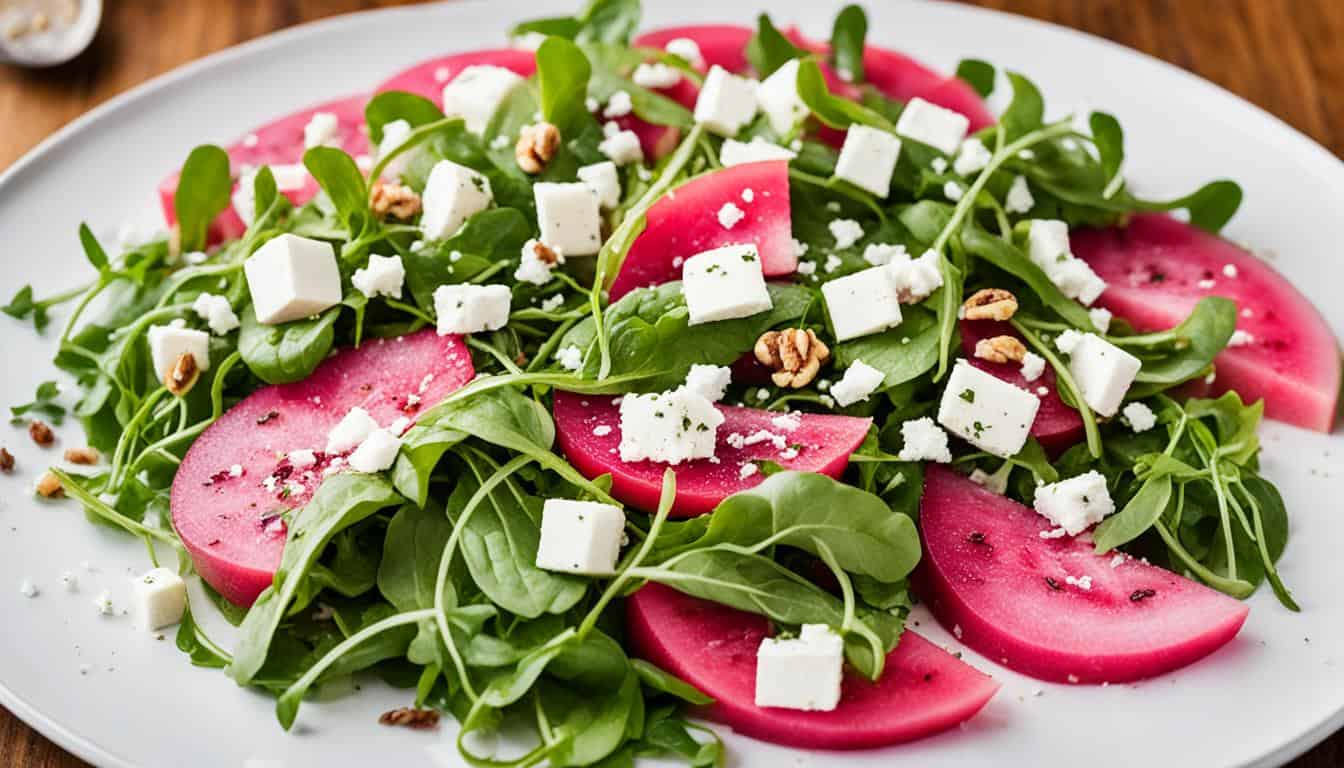

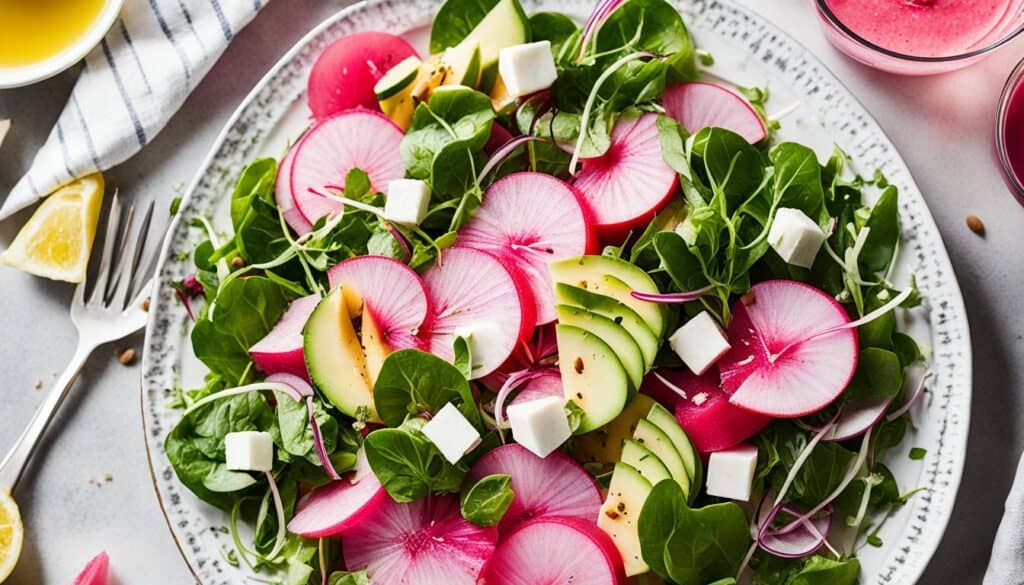
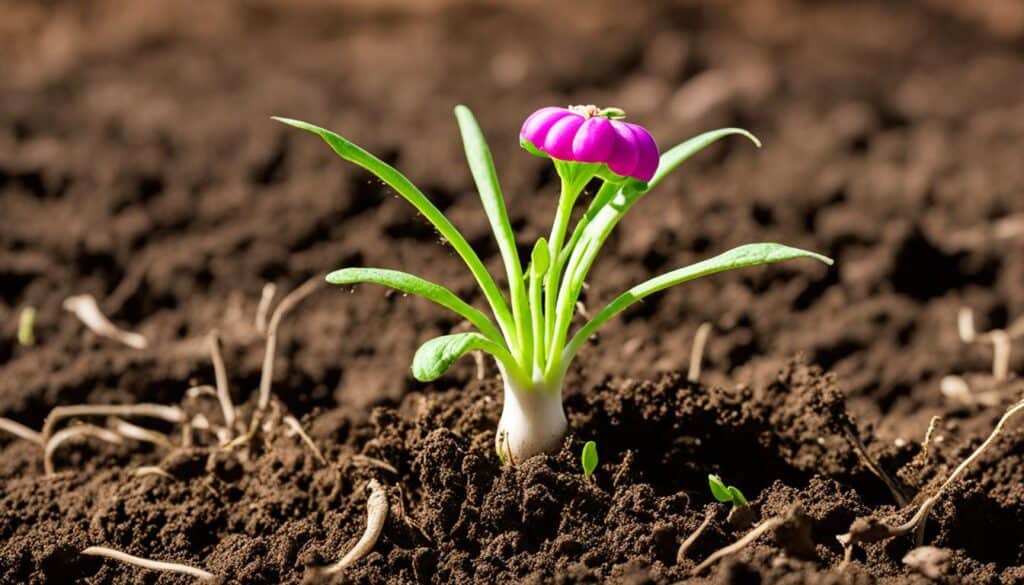
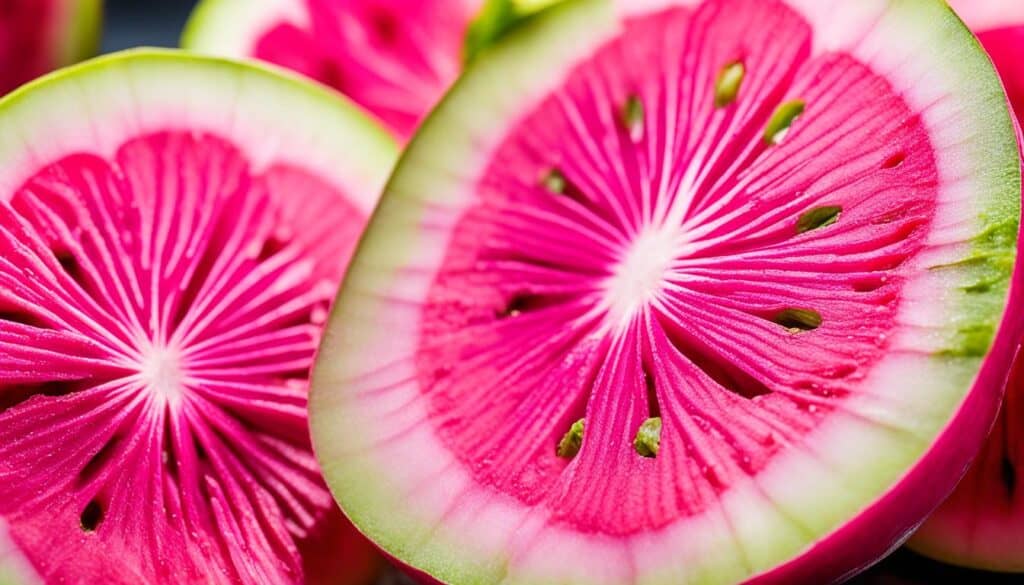
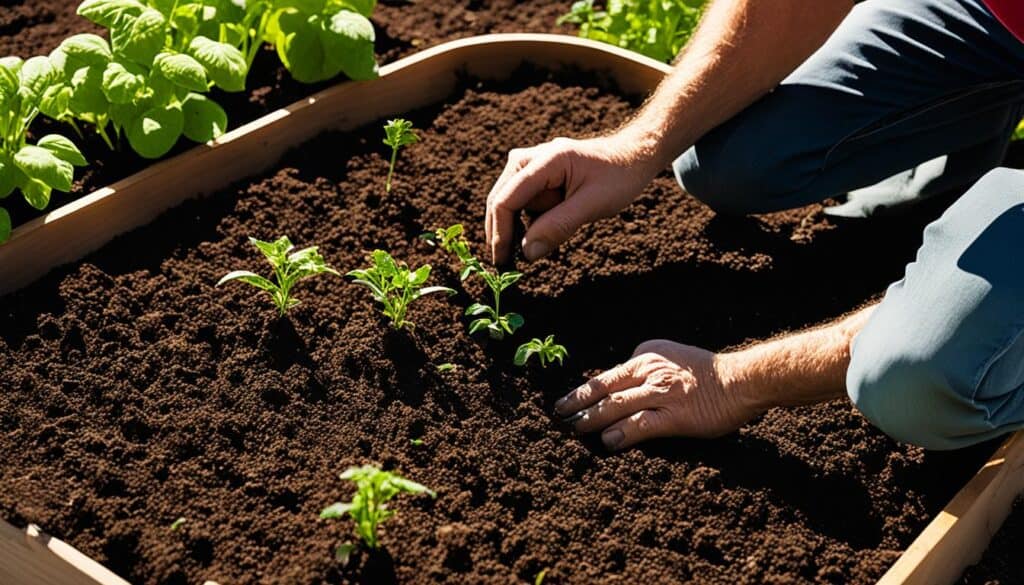



Leave a Reply